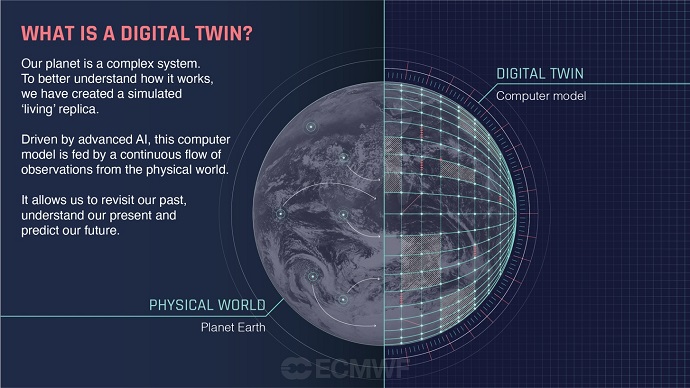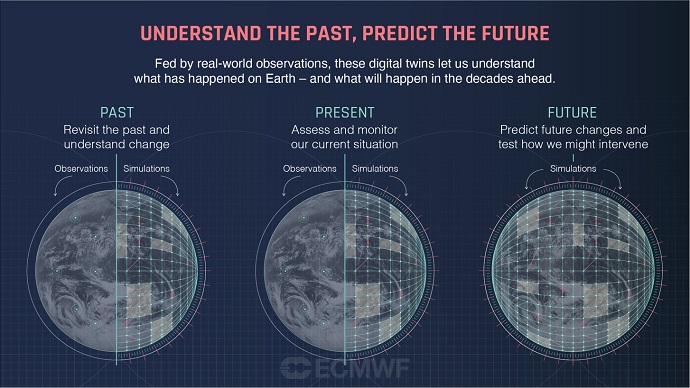Destination Earth (DestinE), is an ambitious initiative of the European Union to create a digital twin – an interactive computer simulation – of our planet.
As extreme weather becomes increasingly frequent and changes in climate more pronounced, there is an urgent need to forecast these events with even greater accuracy, to predict their impact on the environment, life and property.
Using an unprecedented amount of data, innovative Earth system models and cutting-edge computing, Destination Earth will allow users to explore interactively the different components of the Earth system and natural and human-induced change. They will be able to look at the past and present and to test and develop future scenarios.
ECMWF, the European Space Agency (ESA) and the European Organisation for the Exploitation of Meteorological Satellites (EUMETSAT) are the three organisations entrusted by the EU to achieve this unprecedented endeavour for climate, weather and computing sciences.
By pushing the limits of computing and climate sciences, DestinE is a cornerstone of the European Commission’s efforts to boost Europe’s digital capabilities and the Green Deal actions on climate change and to prevent environmental degradation.
The first phase of the programme – its initial implementation phase – will be completed by June 2024. It will focus on configuring, deploying and demonstrating the initial infrastructure building blocks that will support Destination Earth in its future phases.
From 2024 to 2030, these building blocks will further evolve to enhance capabilities, ingest the latest scientific developments and observation information, and make use of the emerging digital infrastructure ecosystem supported by the European Union’s Digital Europe programme.
Our role – building the digital twin engine and the first two digital twins in Destination Earth
By participating in Destination Earth, in coordination and partnership with its Member States, stakeholders in the wider scientific, technological and commercial communities, ECMWF is engaging in one of the most complex challenges in computing science's history.
ECMWF is creating the software and data environment needed to power the high-resolution digital twins, the digital twin engine; and the Centre will also provide the first two digital twins.

The Digital Twin on Weather-Induced and Geophysical Extremes will provide capabilities for the assessment and prediction of environmental extremes in support of risk assessment and management.
The Digital Twin on Climate Change Adaptation will support the analysis and testing of scenarios. This in turn will support sustainable development and climate adaptation and mitigation policy-making at multi-decadal timescales, at regional and national levels.
Both of these digital twins will integrate sea, atmosphere, land, hydrology and sea ice and their deep connections with a level of resolution currently impossible to reach.
The digital twins will draw on ECMWF’s expertise in global numerical weather prediction and high-performance computing, data handling and machine learning; to do this we will use some of the most powerful technical infrastructures in the world.

These developments in Destination Earth take forward the long-term investments of ECMWF Member States in building a unique European prediction capability and will support further advancement of global numerical weather prediction and environmental monitoring.
Alongside the technical developments, the programme will define a multi-level partnership programme ranging from technical co-design with user communities to wider stakeholder engagement throughout its lifetime. Cooperation will therefore continue to be a critical part of Destination Earth, both through partnerships and procurements.

